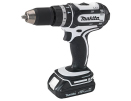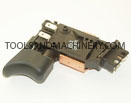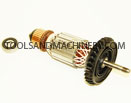Diagnosing a Power Tool That Smokes or Sparks When Engaged…
 Seeing smoke or sparks flying out of your power tool is certainly not a normal nor desired behavior. Despite the scare, though, of a fireworks display breaking out of your power drill, there is a bright side amidst the chaos. Firstly, there are really only two
Seeing smoke or sparks flying out of your power tool is certainly not a normal nor desired behavior. Despite the scare, though, of a fireworks display breaking out of your power drill, there is a bright side amidst the chaos. Firstly, there are really only two places on a power tool where one might find said smoking or sparking action: either from the dust vents or from the switch assembly (pictured to the right). Knowing this, and knowing where the smoke or sparks are coming from, helps us determine exactly where our problem is which puts us only a few steps away from a completely revived power tool.
places on a power tool where one might find said smoking or sparking action: either from the dust vents or from the switch assembly (pictured to the right). Knowing this, and knowing where the smoke or sparks are coming from, helps us determine exactly where our problem is which puts us only a few steps away from a completely revived power tool.
 To begin, if you experience any sparks or smoking form the ventilation points on your tool, there are just three scenarios to consider: One, your armature (left) is bad. Two, your field (right) is bad. And three, both your armature and field are bad. In either
To begin, if you experience any sparks or smoking form the ventilation points on your tool, there are just three scenarios to consider: One, your armature (left) is bad. Two, your field (right) is bad. And three, both your armature and field are bad. In either case, a bad field or armature is most likely the result of your having overheated, over-loaded, or in any other general sense, misused or abused the tool
case, a bad field or armature is most likely the result of your having overheated, over-loaded, or in any other general sense, misused or abused the tool
. You see, although many of us like to believe that our power tools are invincible, they are only designed for certain applications and with certain capacities. If we force them beyond these limitations, there is a very good chance that we will destroy one or several of the tool’s major components. Ultimately though, in the event of a bad field or armature, one or both of them must be replaced.
Secondly, if you experience sparking or smoke from the switch assembly, there is really only one explanation and that is simply that your switch is bad. In this scenario, your switch’s present state of “badness” was likely caused by a shortage in the assembly which, in turn, was most likely caused by moisture damage to the switch, or slightly less likely, by overheating in the tool. In either case the switch must be replaced.
If you’re not sure how to tell which component, between the field and armature, is causing your vents to spark and smoke, it’s truly as simple as dismantling the tool and checking both components for heat-damage. Heat damage will look like burning, charring, melting or any other form or dark or colorful discoloration on the armature and field assemblies or of their wiring and wire insulation. You will need to replace any component with heat damage. While checking the field and armature, you may also want to look at the armature’s commutator. If the bars do not form a perfectly smooth, perfect circle, this can cause the brushes to jump and spark. This form of damage, however, although equally bad and equally needing of replacement, is likely not today’s culprit. Also keep in mind that damage to the armature and field usually comes in pairs, i.e. if one is damaged it’s likely the other is too. If you catch armature damage early, you may sometimes prevent it from spreading to the field, but if your field is damaged, your armature is pretty much out of luck.













